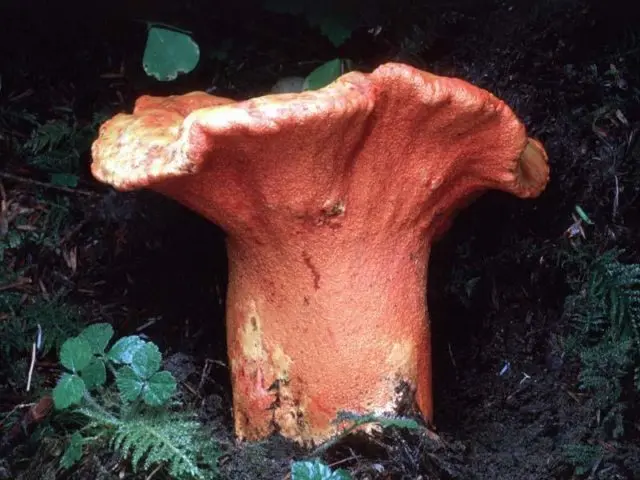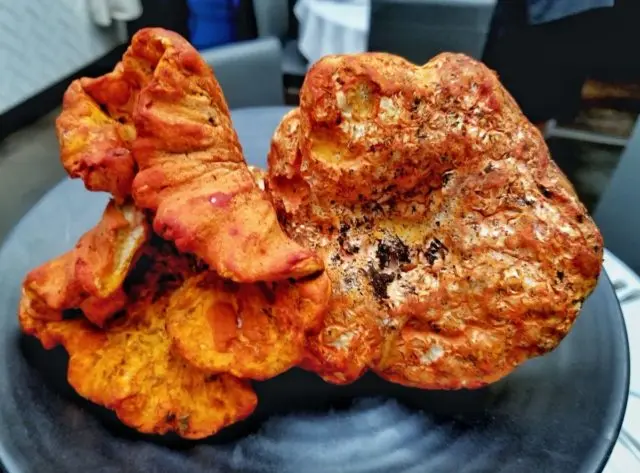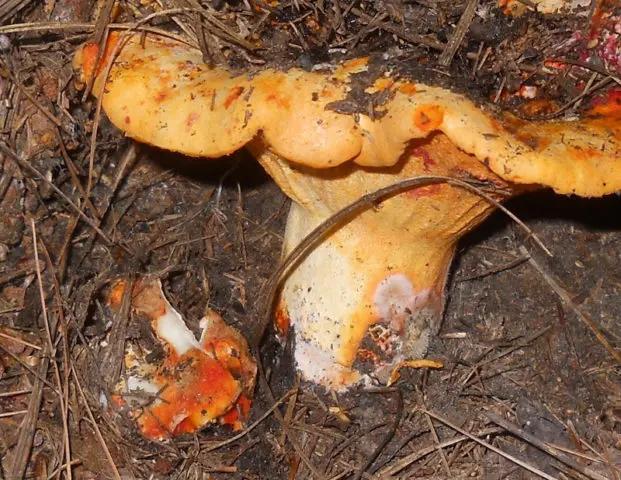Contents
Hypomyces lactiferous is an edible mushroom from the Hypocrean family, the genus Hypomyces. Refers to molds living on the fruiting bodies of other species. Mushrooms inhabited by these parasites are called lobsters.
What does lactic hypomyces look like?
At first, it is a plaque or film of bright orange or red-orange color. Then very small fruiting bodies are formed in the form of a flask, called perithecia. They can be viewed through a magnifying glass. The host fungus colonizes gradually, and as a result, it becomes completely covered with a bright reddish-orange bloom. It is compacted and deformed, the plates on the underside of the cap are smoothed out, its shape can become very bizarre. It is almost impossible to confuse it with any other species.

“Lobster” can reach impressive sizes
In its color, the mushroom on which it parasitizes resembles boiled lobsters. This is how it got its name.
Hypomyces spores are lactiferous white, fusiform, warty, very small in size.

The mold parasite not only changes the color of the host, but also significantly deforms it.
Where does lactic hypomyces grow?
Distributed throughout North America. It is found in mixed forests of the USA, Canada, and also in Mexico. It parasitizes on mushrooms of the Russula family, which include different types of Russula and lactic. Often found on mushrooms.
Lactic hypomyces usually appears after heavy rains, bears fruit for a short time. The “host” after the colonization of the parasite stops its development, spores cease to form.
It occurs only in the wild in combination with other species on which it can parasitize. It is not produced artificially. Fruiting from mid or late July to September.
It is very popular in places where it is common. In the US, lobster mushrooms are sold dried. They can be purchased at farmers markets and some stores. Their price exceeds the cost of dried whites. They are exported to countries in Europe and Asia, especially to Japan and China, where they are considered an exotic product.
Is it possible to eat hypomyces lactiferous
Hypomyces lactalis is edible and is even considered a delicacy. Sometimes there are fears that he can populate poisonous specimens. Most sources reject this, no cases of poisoning have been reported, and a large number of North Americans consume the mushroom.
False doubles
Hypomyces has no similar species. Chanterelles can sometimes be mistaken for lobsters.

Chanterelle resembles a “lobster” in shape, but inferior in size and brightness of color
Collection rules
It is collected together with the host fungus. As a rule, they are cut with a knife or removed from the ground with twisting movements so as not to damage the mycelium. There is information that it is almost never wormy. Sometimes old mushrooms are slightly moldy. In this case, it can be taken if the fruiting body is healthy and not damaged. Moldy areas need to be cut off.

Lobster mushrooms are hard to miss even under a layer of dry leaves and needles.
They can reach large sizes and weigh from 500 g to 1 kg. It is enough to find 2-3 of these mushrooms to fry a large frying pan.
Collecting them is easy as the bright color makes them very visible even when they are trying to hide under fallen leaves.
Use
Lobsters can be used to make many different delicious dishes. Gourmets love them for the rather delicate taste they impart to the pulp of the carrier.
At first, lactic hypomyces has a mushroom aroma, then it becomes similar to the smell of shellfish or fish, which disappears during cooking. The taste is quite mild or slightly spicy.
It is eaten along with the specimen on which it grows. The method of processing depends on what species it parasitizes. It is often fried with other ingredients added.
Hypomyces changes the taste of its carrier, neutralizes its pungency. “Lobsters” with a pungent taste, such as milkers, after the colonization of this parasite lose their sharpness and can be consumed without additional soaking.
Before cooking, they are thoroughly cleaned and washed. Often, pollution penetrates deep into all kinds of bends of hats, such areas must be cut off.
Conclusion
Hypomyces lactis is an unusual edible parasite that is not found in Our Country. The exotic mold is highly valued by American and Canadian gourmets, who collect it in large quantities during the fruiting period.










